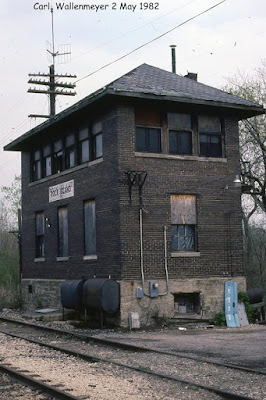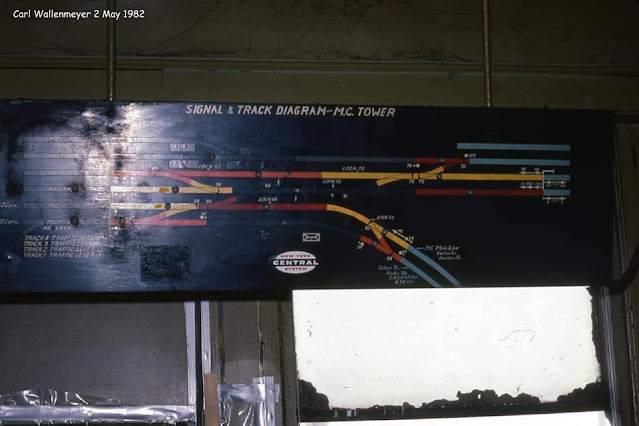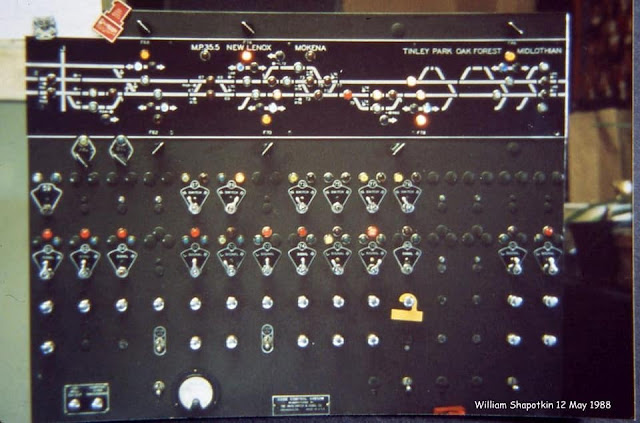NorthAmericanInterlockings: photo, photo, model board
Chicago and Northern Indiana Railroad Interlocking Towers (click the marker for the correct information)
Since I used to confuse the MC and JC (Rock Island) Towers, I show both of them on this topo map using a blue rectangle for MC and a red one for JC. The MC tower controlled where the MC joined the RI tracks for access to the Union Depot.
 |
| 1954 Joliet Quadrangle @ 1:24,000 |
 |
| 1939 Aerial Photo from ILHAP |
 |
| Barriger |
 |
| Mark Llanuza posted It April 1984 a view of EJ&E & Rock Island tower at Joilet IL [Michigan Central tower] and old rock island shops [Note the turntable to the right of the shops.] |
A Dec 30, 2019, comment by Ed Brunner on the UD Tower notes [Google destroyed those notes] explains:
Rock Island Tower (on the EJ&E) was staffed by EJ&E employees. MC Tower (in between UD and RI) was staffed by Rock Island employees.
MC seems to have been originally a tower designed to direct the Michigan Central trains across the Rock Island tracks, using crossovers (rather than a crossing) that Rock Island trains could use to shift from eastbound to west bound tracks or vice versa.
In 1944-45, when CTC was installed from the RI double track Blue Island to Morris, the CTC board was installed at MC in two separate segments: Morris to Joliet and Joliet to Blue Island. When I worked in the tower briefly in 1978, the third shift was covered by an employee from the dispatcher's roster, the other shifts covered by train order clerks. The DS employee covered the job sequentially for several weeks with no down time, then was off for ten sequential rest days (I think it was ten but it could have been eight), and the job was then protected by a DS from the Des Moines office, which is how I showed up there, covering the regular guy's down time.
The Joliet Cutoff of the Michigan Central is now abandoned, but you can still see the bridge where it crossed Hickory Creek on the right side of this satellite image. See Bill Molony's posted photo below of NYC locomotives on this bridge. If you look further east on a modern map, you will find the Old Plank Road Trail. That was the right-of-way (RoW) of the MC.
 |
| Satellite |
 |
| Brian Skrabutenas posted Joel J. Sieracki Michigan Central's Joliet Cut-Off crossed the Rock here on a series of x-overs to get to their yard. |
 |
| Brian Skrabutenas posted |
 |
| Steven Holding posted MC tower from the back porch of a GM&O SD-40 taking ballast to the RI JO yard job in the '70's Richard Mead Yes, the Rock tracks needed a lot of ballast in the early 70s |
 |
| Mark Llanuza posted |
 |
| Bill Molony posted New York Central Railroad F7A #1757 and Pennsylvania Railroad GP9 #7162 crossing Hickory Creek, just east of MC Tower on the Joliet Cutoff in June of 1968. |
Darren Reynold posted eight photos with the comment: "NYCs M.C. Tower Joliet,ILL."
Gregg Gary: PRR & NYC sure gave their operators a lot of CTC to work with.
Bill Haines: Gregg Gary PRR operators had an agreement that only they (not dispatchers) could control interlockings. Hence the term CTC operator.
Tom Barnett: Somehow in the 1980’s, CR era, the carriers, primarily CR, got around that rule (maybe federal labor board decision?) where only operators, by Agreement, “owned the work” of hands on control of interlockings. The agreement was in the old ORT agreement book with the PRR but not in the NYC agreement book. With that Agreement requirement knocked down and out of the way, carriers were free to consolidate everything onto the train dispatcher’s desk after which it was bye bye local tower control rendering the position of operator and the operator’s craft redundant. Same with copying of and delivery of train orders. Operators once owned that particular function of railroading, ie form 19 and form 31’s. Carriers found a way around that rule. They simply went to track warrants, form D’s and other formats of radio block controls directly issued by dispatcher to locomotive engineer or conductor. Thus no need for the carriers to employ a middle man, an operator. I’ve still got copy of my old ORT -NYC lines west of Buffalo Agreement book circa 1951. Unbelievable high number of operator positions once required to handle the movement of trains and mann the local towers and depots.
Howard Swanson: This interlocking was located on the end of a Michigan Central (NYC) branch line from East Gary. At the time of these pictures, a single local served the line with much of the work at Chicago Heights. The branch line was operated under timetable and train order. The CTC panel appears to control the Rock Island through the southern suburbs of Chicago. I’m surprised that a NYC operator (Conrail at the time of the pictures) was responsible for Rock Island territory. I also assume that the interlocking at Joliet station was a Santa Fe job.
 |
| 1 |
 |
| 2 |
 |
| 2 |
 |
| 3 |
 |
| 4 Gary Olden: Union S&S Interlocking Machine. |
 |
| 5 |
 |
| 7 Howard Swanson: Is this the site of Metra’s Joliet Coach Yard? |


No comments:
Post a Comment